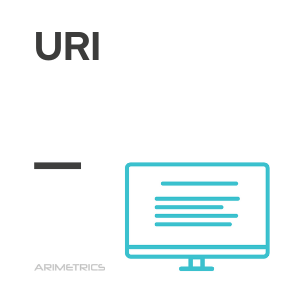
Definition:
URI is short for Uniform Resource Identifier. This generic term is used for all types of names and addresses that refer to Internet objects such as pages, images, videos, etc.
A URI is therefore a string of characters that are used to identify a resource or a name on the Internet. Its purpose is to allow interaction between different resources on the Internet and another type of network.
Difference between URI and URL
A URL (Uniform Resource Locator) is mainly used to point to a web page or part of a web page with schemes or protocols such as http, https, ftp or mailto facilitate access to the location of the resource.
Meanwhile, URI (Uniform Resource Identifier) is used to define the identity of an object, regardless of the method used.
We can claim that a URL is a URI, while a URI may not be a URL.
Types of URIs
There are several types of URIs, each with specific characteristics and purposes. These types allow a more accurate and appropriate identification of resources on the Internet.
- IRI (Internationalized Resource Identifier): This is a generalization of the URI that is fully compatible with international characters, unlike the URI that only supports ASCII encoding.
- URL (Uniform Resource Locator): A type of URI that indicates the location of a resource on the Internet, allowing its location and access.
- URN (Uniform Resource Name): Used to indicate the unique name of a resource on the Internet, providing a unique and public identity without specifying its location.
- URC (Uniform Resource Citation): A set of values that describe an object, including information such as author, date and copyright. It is used to provide metadata about a resource.
URI schema
The scheme of a URI determines how a resource is classified and accessed. Each scheme defines a specific protocol that indicates how to interact with the identified resource.
- http: It is the most common scheme when surfing the Internet, used to access web pages.
- https: Used for secure pages that have an SSL certificate, guaranteeing an encrypted connection.
- mailto: It is the scheme used for e-mail addresses, allowing the opening of a mail client.
- ftp: Used to transfer files using the FTP protocol, facilitating the uploading and downloading of files to and from servers.
Importance of URIs on the Web
URIs are essential to the efficient operation of the web, providing a standardized system for identifying and locating resources. They play a key role in the interoperability and exchange of data in the digital environment. URIs are fundamental to the efficient operation of the web, providing a standardized system for identifying and locating resources. They facilitate interoperability between different systems and applications, allowing resources to be accessed consistently and reliably. In addition, URIs are essential for linking and sharing data on the semantic web, where resources are described and connected in a more intelligent and meaningful way.
